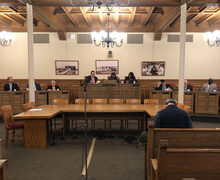Syracuse Fashion Gallery hosts Sustainable Fashion Soiree to teach students upcycling
Jessica Sheldon | Photo Editor
Syracuse Fashion Gallery's Sustainable Fashion Soiree will convert donated clothes into purses.
Every time she would visit a thrift store, Barbara Peterson would look for items with price tags still intact. Labels like Ralph Lauren caught her eye and she would instantly pick those items up, along with a size 1X pair of denim jeans on her way out. But her thrift store purchases would not end up in her closet — they went straight to her sewing machine.
Peterson began upcycling and repurposing several of her thrift store purchases a few years ago, converting the fabric into purses and attaching labels to them. And people loved it, she said. Her upcycled creations were selling for more than $200, and the money helped keep her studio afloat.
“It’s so huge now, you wouldn’t believe,” Peterson said.
Her success encouraged her to take her upcycling to the next level, and passion for her sustainable fashion solidified into events like the Sustainable Fashion Soiree.
The Syracuse Fashion Gallery, a group of five people including Peterson, is hosting the Sustainable Fashion Soiree on Saturday to take in donations of used clothes that can be repurposed.
Donators are welcome to drop by the Sustainable Fashion Soiree and give away their clothes to the gallery. From there, the clothes will be repurposed. The soiree will also double as a holiday party, with cookies, apple cider and a chance for visitors to meet the instructors.
The gallery has some specifications for the clothes that can be donated. 100 percent cotton and natural fabrics are preferred. Cotton is easier to control and work with, as is rayon, linen, batiks and hemp fabric — anything that comes from the earth, Peterson said.
It won’t just be the Peterson and her colleagues participating in upcycling this time. Students will also be there.
The gallery hopes to conduct sewing classes for students to learn about upcycling the donated fabrics. To make these classes, which will begin in January, a success, the gallery has hired a new instructor.
“The kids who do register (for the classes) can just come and have a good time, and don’t have to worry about paying for anything,” Peterson said.
Learning to sew can be expensive, Peterson explained, and that’s where the soiree can help.
“You gotta have your own machine and buy the fabric,” Peterson said about ordinary sewing classes. “You’re spending a good penny just to take a $15 class.”
With donations from the public, students will have material to start their work rather than having to buy their own.
Some students at Syracuse University agree about the sewing classes being enterprising and beneficial in the long term.
“If you teach them to sew and if the fabrics are cheaper (for the students), they’ll be able to have more clothes in the future, and not just like a shirt,” Andie Simon, a sophomore nutrition science major, said.
Peterson herself first developed her love of sewing during her former job as a National Grid employee. She was one of the people “coming to shut your meter off” if electricity bills had been left unpaid.
Meeting people on the job who couldn’t pay their bills changed her, she said.
“These people weren’t getting their meters shut off because they were taking trips to the Bahamas,” she said. “They just didn’t have the money.”
After her retirement from National Grid, Peterson pursued patternmaking, which she was inspired to develop further when she met her daughter’s fashion design instructor, Laurel Morton. Morton has been a part-time instructor in the fashion design program in the School of Design in the College of Visual and Performing Arts since 1997.
Morton often talks about sustainable designs, organic cottons and fibers and ways of upcycling in her classes, which included a sustainable fashion course called “Youth and Fashion: Recycle, Restyle and Rethink.”
She believes the future for designing sustainably must get brighter. Several materials used in fashion are non-biodegradable and could later cause chemical problems, she said.
“We are digging ourselves holes we have to climb out of and mountains that we have to manage,” Morton said.
Peterson sets high standards for the fabrics she buys; she gets her batiks from a family in India and some materials shipped from Africa as well. Beyond merely getting the best material, Peterson gets her fabrics from these sources to support small business and artisans.
“I look at all these large companies and they’re paying people pennies,” she said. “I like to know that the money is going directly to the people who are making the fabrics.”
Peterson believes God blesses those who work with their hands, and that’s why sewing clicked for her, she said.
Creating fresh products out of the old and giving back to the community is a big reason behind Peterson’s efforts to make fashion more sustainable and give students a chance to work with their hands.
“My middle name is ‘Flaxina,’ which means ‘linen’,” she said. “I was supposed to do this, I think.”
Published on December 8, 2016 at 2:20 pm
Contact: dmurthy@syr.edu





